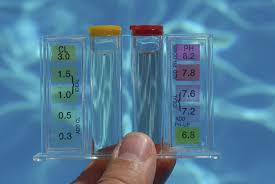Blog
Proper Calcium Hardness Prolongs Deposits.
In addition to pH and total alkalinity, calcium hardness must be kept in balance so that your swimming pool water does not become too corrosive or end up scaling surfaces, such as, water line pool tile, rolled Pebble Tec and water features. These are symptoms of swimming pool water that is unbalanced.
 The recommended range is 150-400 ppm (parts per million), with an often cited stricter range of 200-400 ppm. Keeping your calcium hardness in the midpoint between the low and high should be your goal. Depending on where you live and the hardness level of your local water source, you may have received a slightly different recommended calcium hardness range. For example, here in Arizona, we have notoriously hard water, most of which is pulled from reservoirs up north. This water is very hard, pool service providers keep swimming pool water hardness on the low side, as the hardness will creep up over time just from the act of evaporation, not to mention adding routine sanitizers and water balancing chemicals. How often do you test? Swimming pool calcium hardness does not change quite as fast as other numbers, such as chlorine and pH.
The recommended range is 150-400 ppm (parts per million), with an often cited stricter range of 200-400 ppm. Keeping your calcium hardness in the midpoint between the low and high should be your goal. Depending on where you live and the hardness level of your local water source, you may have received a slightly different recommended calcium hardness range. For example, here in Arizona, we have notoriously hard water, most of which is pulled from reservoirs up north. This water is very hard, pool service providers keep swimming pool water hardness on the low side, as the hardness will creep up over time just from the act of evaporation, not to mention adding routine sanitizers and water balancing chemicals. How often do you test? Swimming pool calcium hardness does not change quite as fast as other numbers, such as chlorine and pH.
We recommend a weekly calcium hardness test, and any time you balance the pool with chemicals, or drain and add water to the pool. If your calcium hardness level tends to remain constant, you can test less often, but it really depends on the relative hardness of your local water source. Additionally, if you had any recent rainwater get in the pool, contaminates like dirt and debris, or a high swimmer use (bather load), then another round of testing is recommended. Excessive hardness in a swimming pool left untreated can result in calcium deposits at the waterline. Pool tile, Pebble Tec and other surfaces can become incrusted with unsightly calcium deposits. Although some of the calcium might free-float in the water, much of it will adhere to pool surfaces.
Also simply called scale, this can cause a wide range of problems. Scaling/calcium deposits can plug pool filters, reduce water circulation through pipes, valves, and fittings. Pool water heaters will run less efficiently, as water flows through a delicate series of copper tubes, called a heat exchanger, to exchange the heater heat to the water. Lastly, the pool water pump will have to work harder to keep the water flowing, reducing its lifespan. The safest and most reliable way to reduce the calcium of your pool is to remove and add fresh water back into your pool. If you have a pool pump and filter that has a backwash option, you can use the occasional backwashing you have to to anyway as an opportunity to remove a little extra pool water and refill the pool with fresh water.
